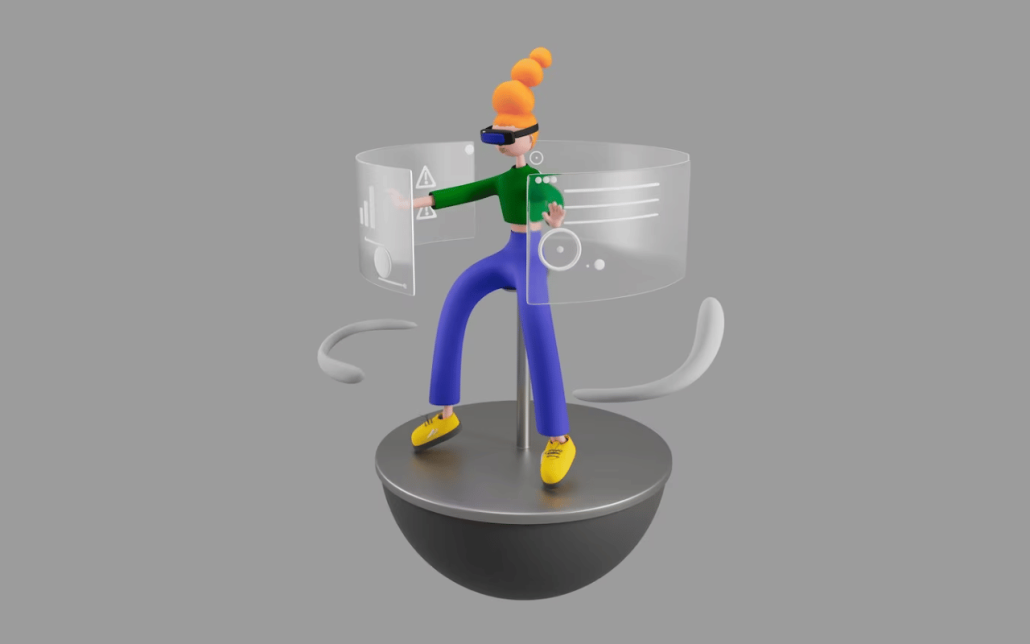3D animation is used in many industries. While 2D animation is overused, 3D animation comes to the game and starts to expand as technology advances. But what is 3D animation used for? The answer is various industries, like:
- Movie and CGI
- Video games
- 3D Explainer and TV Commercial
- Product visualization
- Architecture Renderings and Real Estate
- Medical and Healthcare
- Engineering and Manufacturing Simulations
- Training and Education
- AR and VR
In this blog, we will discover 3D animation uses, benefits, importance, and process. If you are interested to know what is 3D animation used for, keep reading.

Need 3D Animation Services?
Visit our 3D Animation Service page to see how we can help bring your ideas to life!
What is 3D Animation Used for?
3D animation is a valuable tool because of its flexibility in different fields and industries. Among different types of animation, 3D animation is one of the trends these days that can help any industry to improve and stand out from the crowd.
1. Movies & CGI
Among 3D animation uses, we can pinpoint the creation of animated feature films, TV shows, series, and animated music video services. It allows for a wide range of creative possibilities in the film production industry, including VFX, previs, simulation, motion capture integration, etc.
Example: The Na’vi characters in Avatar were created using advanced 3D animation and motion capture technology. Actors wore suits to record movements, and animators translated that to the CGI models. This allowed for very realistic and natural character animation.
2. Video Games
3D animation is used to animate characters, create realistic environments, and generate special effects in a video game. 3D animation is also used in game trailer production. And also game animation services bring the game to life, allowing for visually captivating storytelling.
Example: In the Red Dead Redemption video game, 3D animation brings the interactive open-world environments to life. Players can truly feel immersed in the setting with realistic landscapes, weather effects, and character animations.
3. 3D Explainer and TV Commercial
3D animations are widely used in commercial animation services, advertising, 3D animation explainer video, and promotional videos. It allows businesses to showcase their products or services while capturing viewers’ attention and conveying messages effectively through a perfect explainer video script.
You can gain more information with our guide on “How 3D Explainer Videos Can Help Your Business!” to enhance your marketing strategies.
Example: The iconic Crush orange soda commercials use 3D animation to show the mascot surfing on a wave of orange soda and demonstrating the bubbly, energizing brand. The dynamic animated graphics grab viewer’s attention.
4. Product visualization
During the product design process, 3D animation is invaluable for fully visualizing items in lifelike digital renderings that can be viewed and interacted with. Designers can see products brought to life before physical prototypes are created. Every detail and angle can be perfected with realistic material textures and lighting. This facilitates superior design choices, saving time and money over traditional methods.
Example: Automotive companies like Toyota use 3D animation to fully visualize new car designs digitally, seeing lifelike interactive renderings of the vehicle before physical versions are made. This enables the testing of designs and customization options.
5. Architecture Renderings and Real Estate
In order to create virtual walkthroughs, architectural visualizations, and interior spaces, architects and real estate developers use 3D animation. 3D animation services are big assistants of these industries to boost their sales and improve.
Example: Black Spectacles uses 3D architectural visualization to create detailed, lifelike building renders for clients. All lighting, materials, and environmental factors can be modeled to optimize architectural plans.

6. Medical and Healthcare
In the medical field, 3D animation visualizes human anatomy, medical procedures, and patient education. 3D animation is used to communicate information to patients and visualize surgical interventions.
Example: 3D medical animations of anatomical structures are created for MedSchoolCoach to help students thoroughly learn body systems through dynamic visual models. Students retain information better with the interactive animations.
7. Engineering and Manufacturing Simulations
3D animations play an important role in product design and prototyping to help engineers and manufacturers. They use it to create virtual models, simulations, assembly instructions, production optimization, and training.
Example: NASA utilizes 3D animation to create virtual simulations of rockets and other systems. This allows engineers to iterate and test designs in a digital environment first to refine spacecraft before physical creation.

8. Training and Education
3D animation is used in different aspects of educational materials, like e-learning courses and simulations. Using animation in education makes it easier to present complex content and improves understanding and learning outcomes.
Example: UPS uses detailed 3D animated videos to better train drivers on delivering packages safely and efficiently. The engaging visual medium improves comprehension of proper procedures.
9. AR and VR
Holding a mirror into the future of 3D animation, the basis of virtual reality and augmented reality is formed by this form of art. Virtual environments, interactive simulations, and immersive user interactions open up new possibilities in gaming, training, and experiential applications.
Example: IKEA Place allows customers to preview true-to-scale 3D renderings of furniture in their own homes using AR. Shoppers can view and interact with photorealistic models to see products in context before purchasing.

2D vs. 3D Animation: Choosing the Right Style
2D animation is different from 3D animation. 2D works on a flat screen. It uses hand-drawn pictures. You see it in classic cartoons. 3D animation creates a world with depth. It has lifelike characters and detailed places. You can move the camera around. This is hard to do in 2D.
The choice between them depends on a few things. You have to think about how you want it to look. You also have to think about the budget. 3D animation usually costs more time and money. It’s for when you want things to look more real.
Why is 3D Animation Important?
3D animation is important for several reasons, from realistic visuals to time and cost savings.
- 3D animation allows us to create highly realistic visuals.
- 3D animation offers limitless creative possibilities.
- 3D animation conveys ideas and concepts effectively.
- 3D animation helps in problem-solving and prototyping.
- 3D animation outsourcing leads to cost and time savings in the long run.
- 3D animation has driven advancements in technology.
- 3D animation pushes the boundaries of creativity.
What Are the Benefits of 3D Animation?
There are many benefits of 3D animation, like flexibility, creativity, versatility, cost and time efficiency, simulation, visualization, real-time interactivity, enhanced storytelling, versatility across industries, prototyping, and global collaboration. If you are in two minds about choosing between 3D animation or other types, read our Advantages of 3D Animation blog post.
The Business Case: Measuring the ROI of 3D Animation
For businesses, deciding to get into 3D animation is about what you get back for your money. It can cost a lot at the start. But the benefits are worth more than the cost. It can bring real value to a business.
For example, you can use 3D to show what a product looks like. This saves a ton of money by not needing to build a real prototype. 3D ads also get more people to buy things and remember your brand. Companies can use it for training and education too. This saves money on in-person training. Being able to see a project digitally also helps avoid problems and makes the whole process smoother. 3D animation is not just for art; it’s a powerful tool for a business.
How Does 3D Animation Work?
3D animation production involves a multi-step process. Here’s a simplified overview of how 3D animation works, but if you want to know it in detail, read our 3D animation production pipeline blog post.
Pre-Production
- Animation idea
- Concept art
- Story creating
- Scriptwriting
- Storyboarding
- Animatic
- Design
Production
Post-Production
- composting
- 2D VFX
- Color correction
- Final output

Beyond the Technical: The Creative Roles in 3D Animation
The technical part of 3D animation is important. But it’s the creative people who make it feel alive. These roles are more than just using a computer. They are the artists who decide how the project looks and feels.
A character designer makes the way the animated people look. A storyboard artist plans out the story. The art director sets the style, making sure everything fits together. A 3D animator doesn’t just move models. They act with them. They show emotions and personality through how they move. These creative jobs are the heart of animation. They turn a bunch of technical steps into a great piece of art.
What is the Future of 3D Animation?
The future of the 3D animation industry is combined with technological improvement. Here are some key areas that are expected to shape the future of 3D animation:
Real-Time Rendering: Development of more powerful hardware or rendering engines and animation software.
VR and AR: Increased demand for immersive and interactive 3D content.
Machine Learning and AI: Using AI-driven tools to streamline workflows and efficiently generate complex animations.
Generative Animation: Enabling the generation of animations based on algorithms and rules rather than manual keyframing.
Cross-Platform Compatibility: The growth of devices and platforms leads to more need for cross-platform compatibility and transmedia storytelling.
Integration with Other Technologies: Create more immersive and interactive experiences.
Conclusion
In conclusion, 3D animation is a powerful tool with the ability to create realistic visuals, provide creative freedom, and engage audiences. 3D animation uses are increasing day by day in several fields and industries, like film, video games, AR/VR, advertising, explainer videos, architecture, prototyping, healthcare, education, and engineering. The future of 3D animation holds exciting prospects. As technology continues to advance, the benefits of 3D animation show their impact more and more. The 3D animation production process will also be simplified over time.









